Green Leases in UK Real Estate: Benefits, Issues, and Regulations
VerifiedAdded on 2022/08/22
|10
|2179
|17
Report
AI Summary
This report provides a comprehensive analysis of green leases within the UK real estate market. It begins with an introduction to green leases, defining their role in promoting sustainability and energy efficiency in commercial and public buildings. The discussion section explores key aspects of green leases, including their essential elements such as building management committees, dispute resolution processes, and energy management plans. The report highlights the benefits of green leases, such as reduced resource consumption and improved corporate image, while also addressing the issues faced by commercial property asset managers. A significant portion of the report delves into the legal terminology used in green leases and the challenges associated with the 'split incentive' issue, where the costs and benefits of sustainability measures are not aligned between property owners and tenants. Furthermore, the report examines the impact of Minimum Energy Efficiency Standards (MEES) and their influence on lease agreements. The report concludes by emphasizing the increasing interest in green leases and their potential for long-term benefits, advocating for government clarity on related issues. The report is supported by references to academic literature and industry publications.
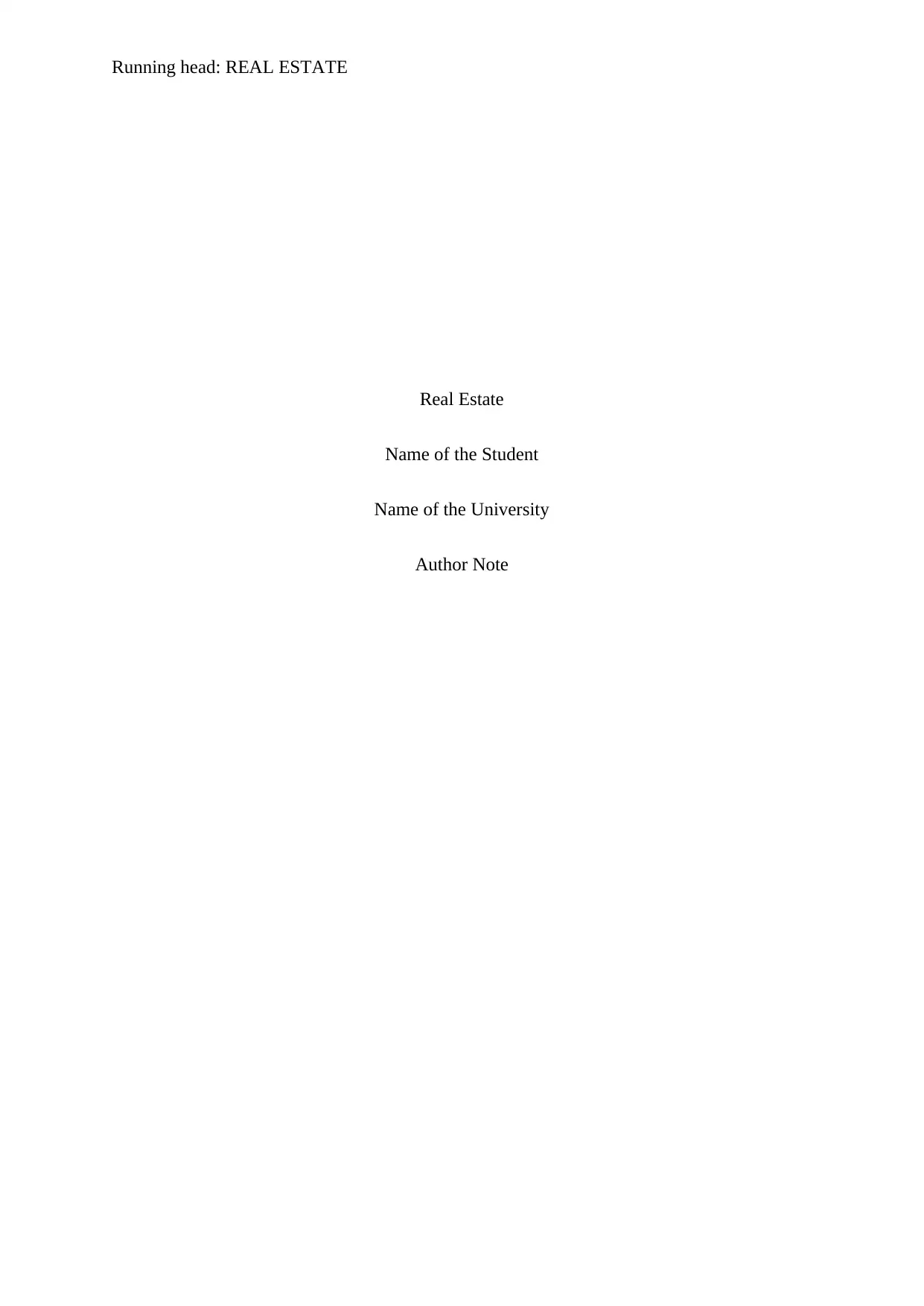
Running head: REAL ESTATE
Real Estate
Name of the Student
Name of the University
Author Note
Real Estate
Name of the Student
Name of the University
Author Note
Paraphrase This Document
Need a fresh take? Get an instant paraphrase of this document with our AI Paraphraser
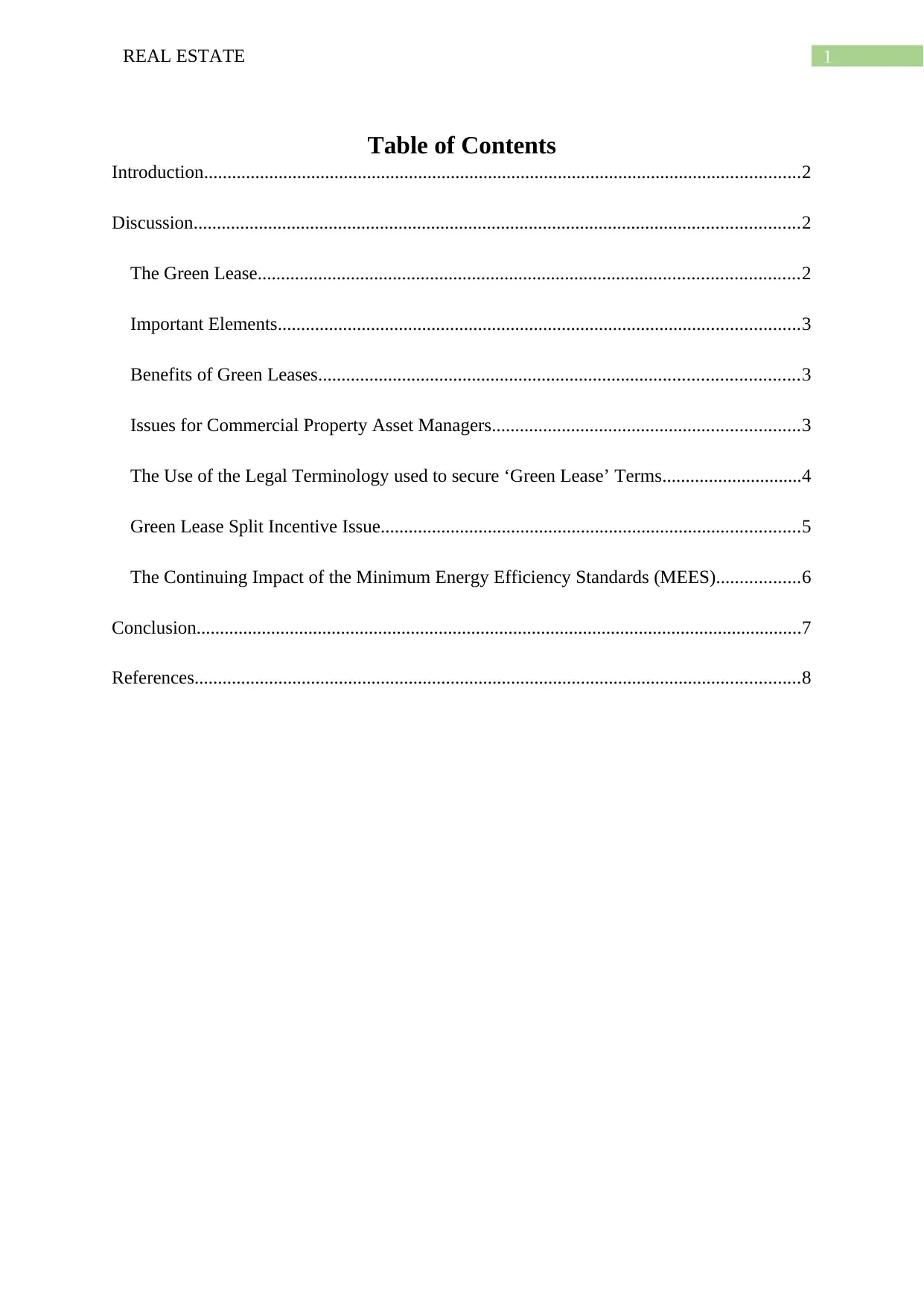
1REAL ESTATE
Table of Contents
Introduction................................................................................................................................2
Discussion..................................................................................................................................2
The Green Lease....................................................................................................................2
Important Elements................................................................................................................3
Benefits of Green Leases.......................................................................................................3
Issues for Commercial Property Asset Managers..................................................................3
The Use of the Legal Terminology used to secure ‘Green Lease’ Terms..............................4
Green Lease Split Incentive Issue..........................................................................................5
The Continuing Impact of the Minimum Energy Efficiency Standards (MEES)..................6
Conclusion..................................................................................................................................7
References..................................................................................................................................8
Table of Contents
Introduction................................................................................................................................2
Discussion..................................................................................................................................2
The Green Lease....................................................................................................................2
Important Elements................................................................................................................3
Benefits of Green Leases.......................................................................................................3
Issues for Commercial Property Asset Managers..................................................................3
The Use of the Legal Terminology used to secure ‘Green Lease’ Terms..............................4
Green Lease Split Incentive Issue..........................................................................................5
The Continuing Impact of the Minimum Energy Efficiency Standards (MEES)..................6
Conclusion..................................................................................................................................7
References..................................................................................................................................8
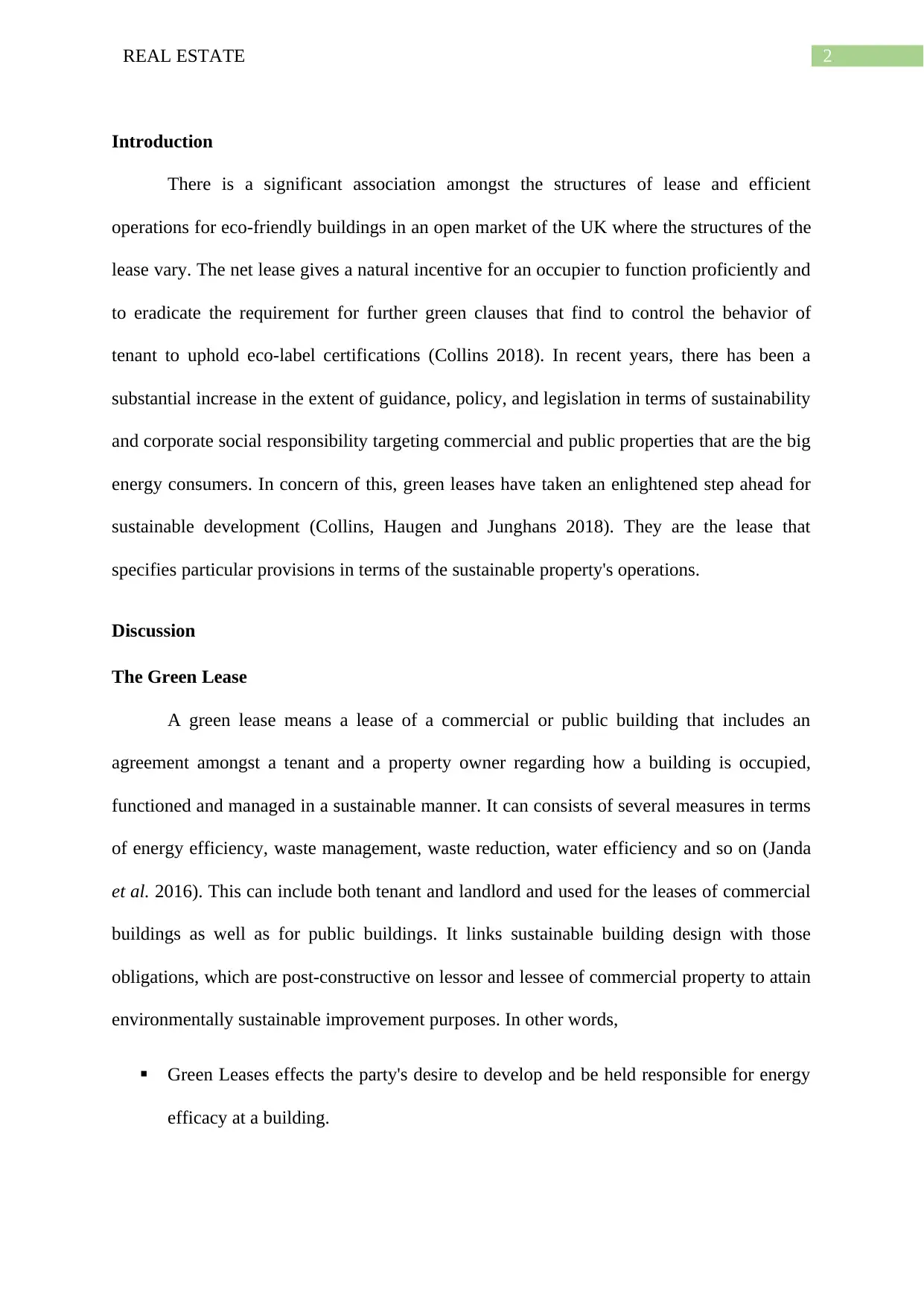
2REAL ESTATE
Introduction
There is a significant association amongst the structures of lease and efficient
operations for eco-friendly buildings in an open market of the UK where the structures of the
lease vary. The net lease gives a natural incentive for an occupier to function proficiently and
to eradicate the requirement for further green clauses that find to control the behavior of
tenant to uphold eco-label certifications (Collins 2018). In recent years, there has been a
substantial increase in the extent of guidance, policy, and legislation in terms of sustainability
and corporate social responsibility targeting commercial and public properties that are the big
energy consumers. In concern of this, green leases have taken an enlightened step ahead for
sustainable development (Collins, Haugen and Junghans 2018). They are the lease that
specifies particular provisions in terms of the sustainable property's operations.
Discussion
The Green Lease
A green lease means a lease of a commercial or public building that includes an
agreement amongst a tenant and a property owner regarding how a building is occupied,
functioned and managed in a sustainable manner. It can consists of several measures in terms
of energy efficiency, waste management, waste reduction, water efficiency and so on (Janda
et al. 2016). This can include both tenant and landlord and used for the leases of commercial
buildings as well as for public buildings. It links sustainable building design with those
obligations, which are post-constructive on lessor and lessee of commercial property to attain
environmentally sustainable improvement purposes. In other words,
Green Leases effects the party's desire to develop and be held responsible for energy
efficacy at a building.
Introduction
There is a significant association amongst the structures of lease and efficient
operations for eco-friendly buildings in an open market of the UK where the structures of the
lease vary. The net lease gives a natural incentive for an occupier to function proficiently and
to eradicate the requirement for further green clauses that find to control the behavior of
tenant to uphold eco-label certifications (Collins 2018). In recent years, there has been a
substantial increase in the extent of guidance, policy, and legislation in terms of sustainability
and corporate social responsibility targeting commercial and public properties that are the big
energy consumers. In concern of this, green leases have taken an enlightened step ahead for
sustainable development (Collins, Haugen and Junghans 2018). They are the lease that
specifies particular provisions in terms of the sustainable property's operations.
Discussion
The Green Lease
A green lease means a lease of a commercial or public building that includes an
agreement amongst a tenant and a property owner regarding how a building is occupied,
functioned and managed in a sustainable manner. It can consists of several measures in terms
of energy efficiency, waste management, waste reduction, water efficiency and so on (Janda
et al. 2016). This can include both tenant and landlord and used for the leases of commercial
buildings as well as for public buildings. It links sustainable building design with those
obligations, which are post-constructive on lessor and lessee of commercial property to attain
environmentally sustainable improvement purposes. In other words,
Green Leases effects the party's desire to develop and be held responsible for energy
efficacy at a building.
⊘ This is a preview!⊘
Do you want full access?
Subscribe today to unlock all pages.

Trusted by 1+ million students worldwide
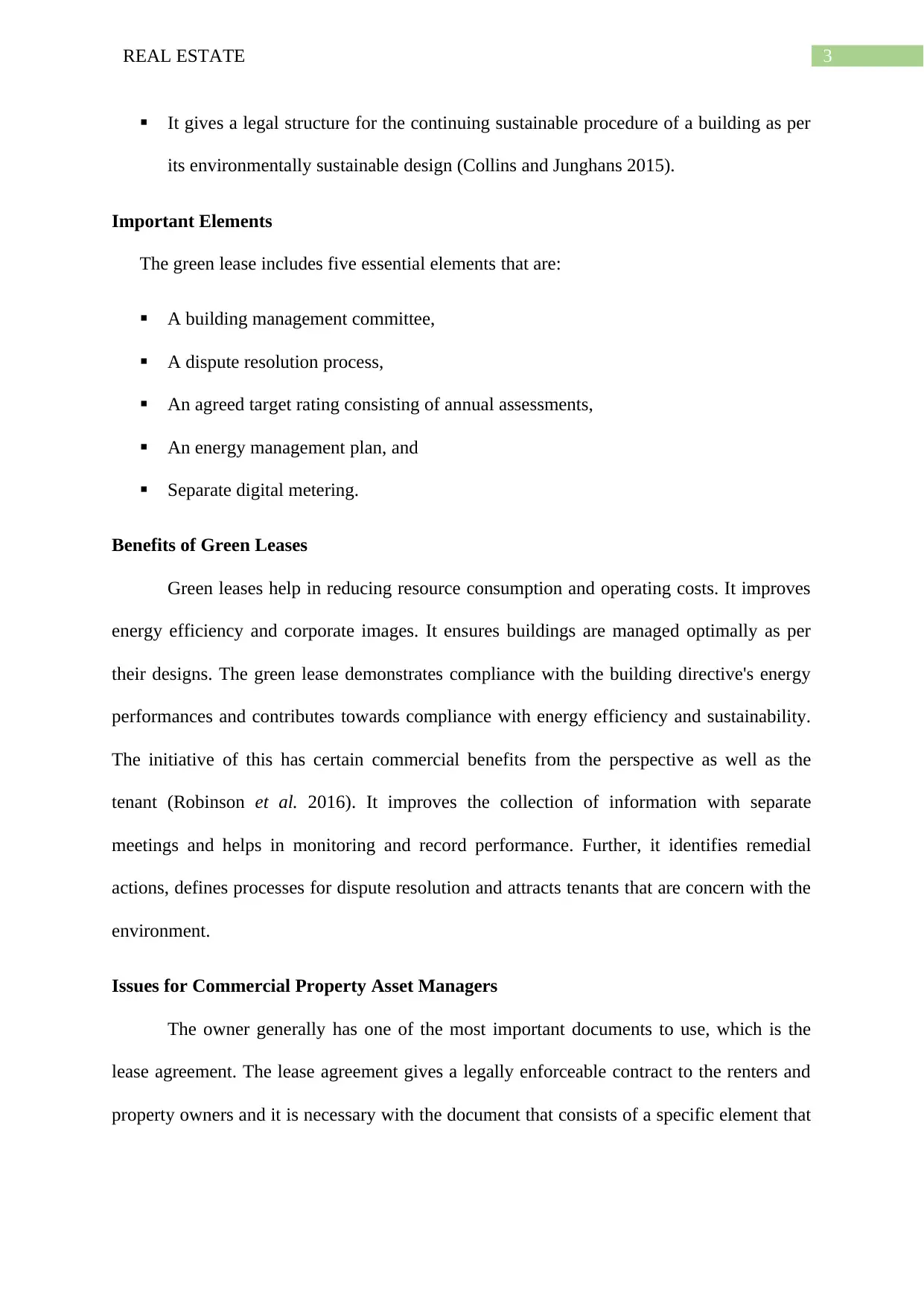
3REAL ESTATE
It gives a legal structure for the continuing sustainable procedure of a building as per
its environmentally sustainable design (Collins and Junghans 2015).
Important Elements
The green lease includes five essential elements that are:
A building management committee,
A dispute resolution process,
An agreed target rating consisting of annual assessments,
An energy management plan, and
Separate digital metering.
Benefits of Green Leases
Green leases help in reducing resource consumption and operating costs. It improves
energy efficiency and corporate images. It ensures buildings are managed optimally as per
their designs. The green lease demonstrates compliance with the building directive's energy
performances and contributes towards compliance with energy efficiency and sustainability.
The initiative of this has certain commercial benefits from the perspective as well as the
tenant (Robinson et al. 2016). It improves the collection of information with separate
meetings and helps in monitoring and record performance. Further, it identifies remedial
actions, defines processes for dispute resolution and attracts tenants that are concern with the
environment.
Issues for Commercial Property Asset Managers
The owner generally has one of the most important documents to use, which is the
lease agreement. The lease agreement gives a legally enforceable contract to the renters and
property owners and it is necessary with the document that consists of a specific element that
It gives a legal structure for the continuing sustainable procedure of a building as per
its environmentally sustainable design (Collins and Junghans 2015).
Important Elements
The green lease includes five essential elements that are:
A building management committee,
A dispute resolution process,
An agreed target rating consisting of annual assessments,
An energy management plan, and
Separate digital metering.
Benefits of Green Leases
Green leases help in reducing resource consumption and operating costs. It improves
energy efficiency and corporate images. It ensures buildings are managed optimally as per
their designs. The green lease demonstrates compliance with the building directive's energy
performances and contributes towards compliance with energy efficiency and sustainability.
The initiative of this has certain commercial benefits from the perspective as well as the
tenant (Robinson et al. 2016). It improves the collection of information with separate
meetings and helps in monitoring and record performance. Further, it identifies remedial
actions, defines processes for dispute resolution and attracts tenants that are concern with the
environment.
Issues for Commercial Property Asset Managers
The owner generally has one of the most important documents to use, which is the
lease agreement. The lease agreement gives a legally enforceable contract to the renters and
property owners and it is necessary with the document that consists of a specific element that
Paraphrase This Document
Need a fresh take? Get an instant paraphrase of this document with our AI Paraphraser
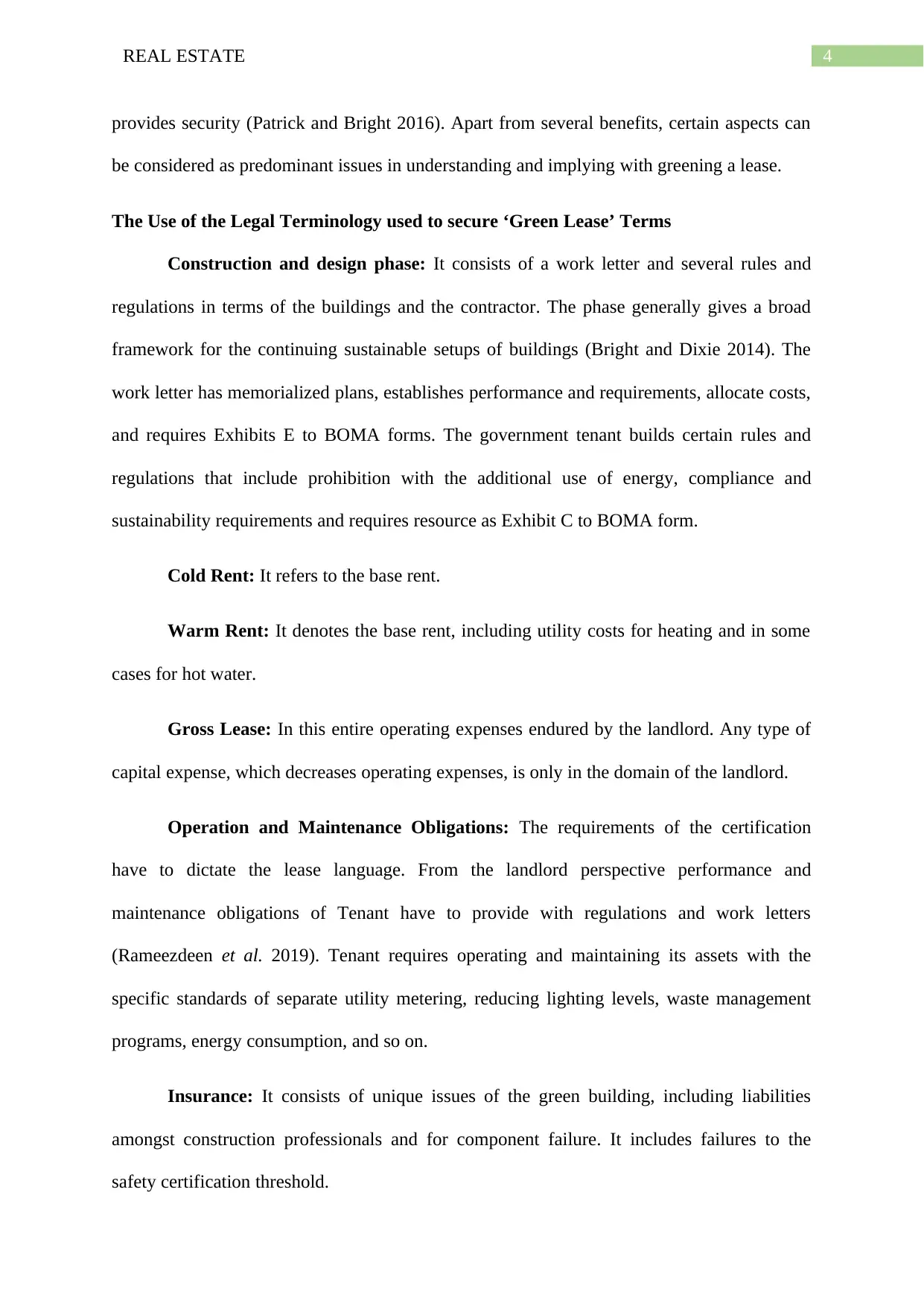
4REAL ESTATE
provides security (Patrick and Bright 2016). Apart from several benefits, certain aspects can
be considered as predominant issues in understanding and implying with greening a lease.
The Use of the Legal Terminology used to secure ‘Green Lease’ Terms
Construction and design phase: It consists of a work letter and several rules and
regulations in terms of the buildings and the contractor. The phase generally gives a broad
framework for the continuing sustainable setups of buildings (Bright and Dixie 2014). The
work letter has memorialized plans, establishes performance and requirements, allocate costs,
and requires Exhibits E to BOMA forms. The government tenant builds certain rules and
regulations that include prohibition with the additional use of energy, compliance and
sustainability requirements and requires resource as Exhibit C to BOMA form.
Cold Rent: It refers to the base rent.
Warm Rent: It denotes the base rent, including utility costs for heating and in some
cases for hot water.
Gross Lease: In this entire operating expenses endured by the landlord. Any type of
capital expense, which decreases operating expenses, is only in the domain of the landlord.
Operation and Maintenance Obligations: The requirements of the certification
have to dictate the lease language. From the landlord perspective performance and
maintenance obligations of Tenant have to provide with regulations and work letters
(Rameezdeen et al. 2019). Tenant requires operating and maintaining its assets with the
specific standards of separate utility metering, reducing lighting levels, waste management
programs, energy consumption, and so on.
Insurance: It consists of unique issues of the green building, including liabilities
amongst construction professionals and for component failure. It includes failures to the
safety certification threshold.
provides security (Patrick and Bright 2016). Apart from several benefits, certain aspects can
be considered as predominant issues in understanding and implying with greening a lease.
The Use of the Legal Terminology used to secure ‘Green Lease’ Terms
Construction and design phase: It consists of a work letter and several rules and
regulations in terms of the buildings and the contractor. The phase generally gives a broad
framework for the continuing sustainable setups of buildings (Bright and Dixie 2014). The
work letter has memorialized plans, establishes performance and requirements, allocate costs,
and requires Exhibits E to BOMA forms. The government tenant builds certain rules and
regulations that include prohibition with the additional use of energy, compliance and
sustainability requirements and requires resource as Exhibit C to BOMA form.
Cold Rent: It refers to the base rent.
Warm Rent: It denotes the base rent, including utility costs for heating and in some
cases for hot water.
Gross Lease: In this entire operating expenses endured by the landlord. Any type of
capital expense, which decreases operating expenses, is only in the domain of the landlord.
Operation and Maintenance Obligations: The requirements of the certification
have to dictate the lease language. From the landlord perspective performance and
maintenance obligations of Tenant have to provide with regulations and work letters
(Rameezdeen et al. 2019). Tenant requires operating and maintaining its assets with the
specific standards of separate utility metering, reducing lighting levels, waste management
programs, energy consumption, and so on.
Insurance: It consists of unique issues of the green building, including liabilities
amongst construction professionals and for component failure. It includes failures to the
safety certification threshold.
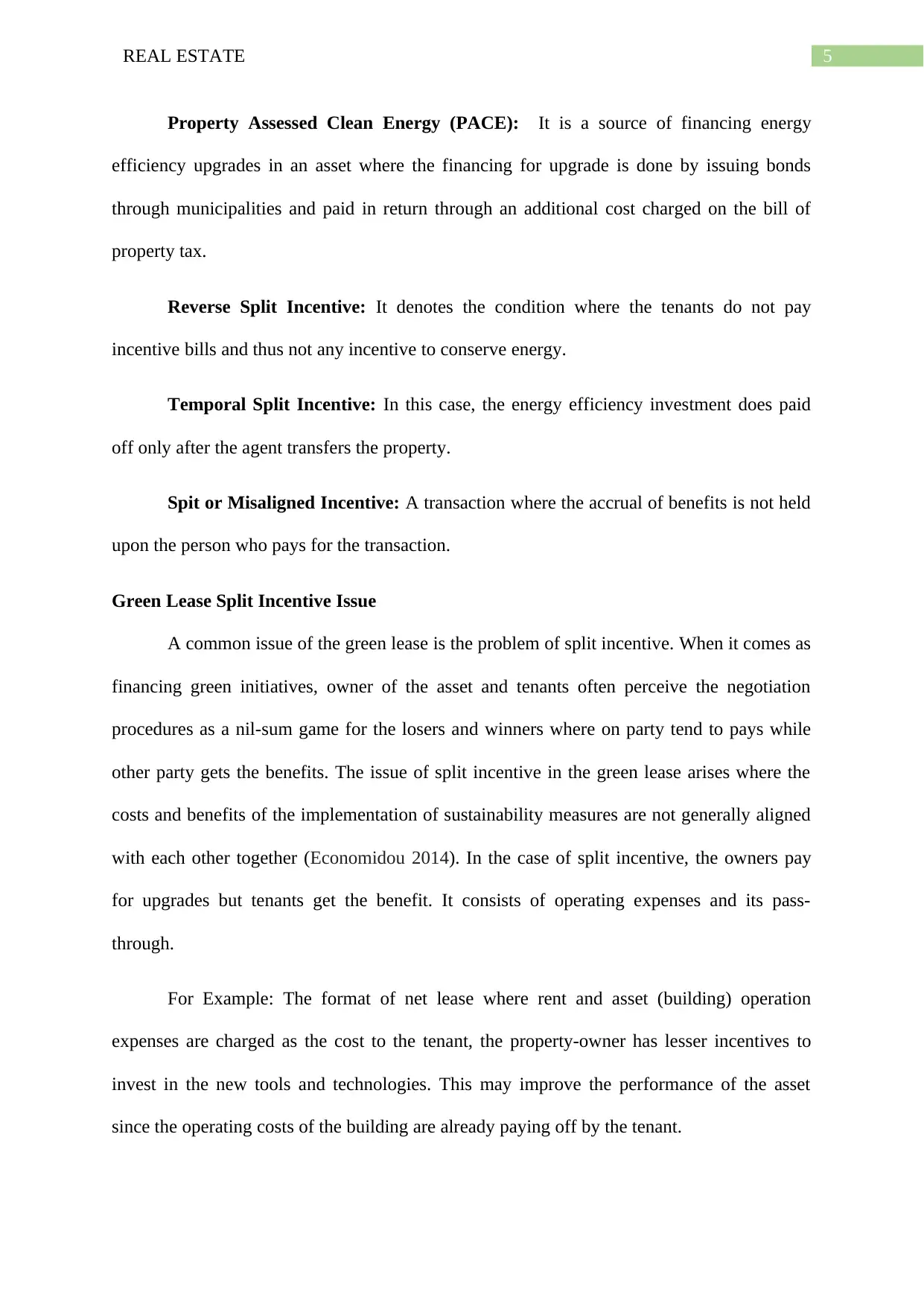
5REAL ESTATE
Property Assessed Clean Energy (PACE): It is a source of financing energy
efficiency upgrades in an asset where the financing for upgrade is done by issuing bonds
through municipalities and paid in return through an additional cost charged on the bill of
property tax.
Reverse Split Incentive: It denotes the condition where the tenants do not pay
incentive bills and thus not any incentive to conserve energy.
Temporal Split Incentive: In this case, the energy efficiency investment does paid
off only after the agent transfers the property.
Spit or Misaligned Incentive: A transaction where the accrual of benefits is not held
upon the person who pays for the transaction.
Green Lease Split Incentive Issue
A common issue of the green lease is the problem of split incentive. When it comes as
financing green initiatives, owner of the asset and tenants often perceive the negotiation
procedures as a nil-sum game for the losers and winners where on party tend to pays while
other party gets the benefits. The issue of split incentive in the green lease arises where the
costs and benefits of the implementation of sustainability measures are not generally aligned
with each other together (Economidou 2014). In the case of split incentive, the owners pay
for upgrades but tenants get the benefit. It consists of operating expenses and its pass-
through.
For Example: The format of net lease where rent and asset (building) operation
expenses are charged as the cost to the tenant, the property-owner has lesser incentives to
invest in the new tools and technologies. This may improve the performance of the asset
since the operating costs of the building are already paying off by the tenant.
Property Assessed Clean Energy (PACE): It is a source of financing energy
efficiency upgrades in an asset where the financing for upgrade is done by issuing bonds
through municipalities and paid in return through an additional cost charged on the bill of
property tax.
Reverse Split Incentive: It denotes the condition where the tenants do not pay
incentive bills and thus not any incentive to conserve energy.
Temporal Split Incentive: In this case, the energy efficiency investment does paid
off only after the agent transfers the property.
Spit or Misaligned Incentive: A transaction where the accrual of benefits is not held
upon the person who pays for the transaction.
Green Lease Split Incentive Issue
A common issue of the green lease is the problem of split incentive. When it comes as
financing green initiatives, owner of the asset and tenants often perceive the negotiation
procedures as a nil-sum game for the losers and winners where on party tend to pays while
other party gets the benefits. The issue of split incentive in the green lease arises where the
costs and benefits of the implementation of sustainability measures are not generally aligned
with each other together (Economidou 2014). In the case of split incentive, the owners pay
for upgrades but tenants get the benefit. It consists of operating expenses and its pass-
through.
For Example: The format of net lease where rent and asset (building) operation
expenses are charged as the cost to the tenant, the property-owner has lesser incentives to
invest in the new tools and technologies. This may improve the performance of the asset
since the operating costs of the building are already paying off by the tenant.
⊘ This is a preview!⊘
Do you want full access?
Subscribe today to unlock all pages.

Trusted by 1+ million students worldwide
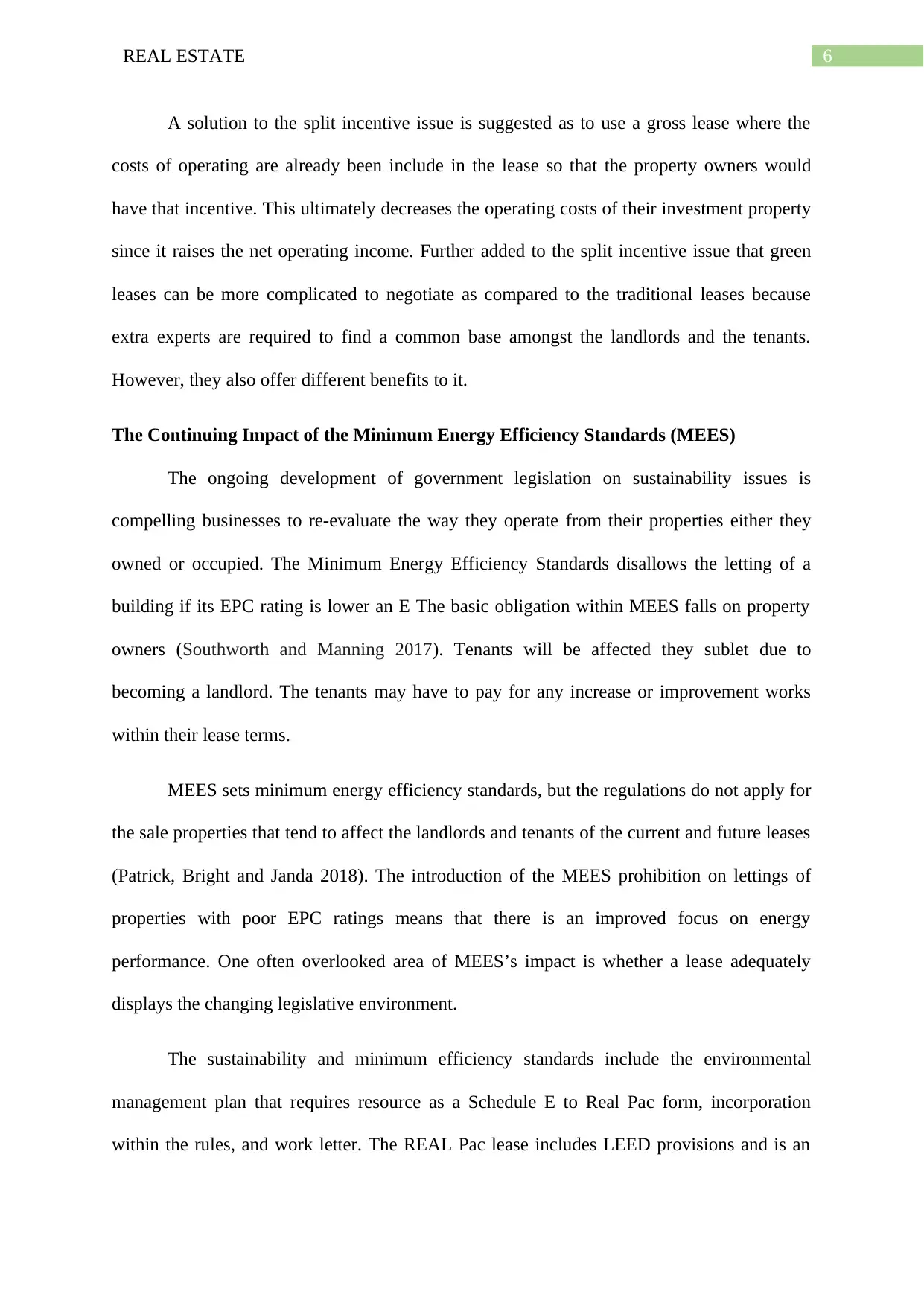
6REAL ESTATE
A solution to the split incentive issue is suggested as to use a gross lease where the
costs of operating are already been include in the lease so that the property owners would
have that incentive. This ultimately decreases the operating costs of their investment property
since it raises the net operating income. Further added to the split incentive issue that green
leases can be more complicated to negotiate as compared to the traditional leases because
extra experts are required to find a common base amongst the landlords and the tenants.
However, they also offer different benefits to it.
The Continuing Impact of the Minimum Energy Efficiency Standards (MEES)
The ongoing development of government legislation on sustainability issues is
compelling businesses to re-evaluate the way they operate from their properties either they
owned or occupied. The Minimum Energy Efficiency Standards disallows the letting of a
building if its EPC rating is lower an E The basic obligation within MEES falls on property
owners (Southworth and Manning 2017). Tenants will be affected they sublet due to
becoming a landlord. The tenants may have to pay for any increase or improvement works
within their lease terms.
MEES sets minimum energy efficiency standards, but the regulations do not apply for
the sale properties that tend to affect the landlords and tenants of the current and future leases
(Patrick, Bright and Janda 2018). The introduction of the MEES prohibition on lettings of
properties with poor EPC ratings means that there is an improved focus on energy
performance. One often overlooked area of MEES’s impact is whether a lease adequately
displays the changing legislative environment.
The sustainability and minimum efficiency standards include the environmental
management plan that requires resource as a Schedule E to Real Pac form, incorporation
within the rules, and work letter. The REAL Pac lease includes LEED provisions and is an
A solution to the split incentive issue is suggested as to use a gross lease where the
costs of operating are already been include in the lease so that the property owners would
have that incentive. This ultimately decreases the operating costs of their investment property
since it raises the net operating income. Further added to the split incentive issue that green
leases can be more complicated to negotiate as compared to the traditional leases because
extra experts are required to find a common base amongst the landlords and the tenants.
However, they also offer different benefits to it.
The Continuing Impact of the Minimum Energy Efficiency Standards (MEES)
The ongoing development of government legislation on sustainability issues is
compelling businesses to re-evaluate the way they operate from their properties either they
owned or occupied. The Minimum Energy Efficiency Standards disallows the letting of a
building if its EPC rating is lower an E The basic obligation within MEES falls on property
owners (Southworth and Manning 2017). Tenants will be affected they sublet due to
becoming a landlord. The tenants may have to pay for any increase or improvement works
within their lease terms.
MEES sets minimum energy efficiency standards, but the regulations do not apply for
the sale properties that tend to affect the landlords and tenants of the current and future leases
(Patrick, Bright and Janda 2018). The introduction of the MEES prohibition on lettings of
properties with poor EPC ratings means that there is an improved focus on energy
performance. One often overlooked area of MEES’s impact is whether a lease adequately
displays the changing legislative environment.
The sustainability and minimum efficiency standards include the environmental
management plan that requires resource as a Schedule E to Real Pac form, incorporation
within the rules, and work letter. The REAL Pac lease includes LEED provisions and is an
Paraphrase This Document
Need a fresh take? Get an instant paraphrase of this document with our AI Paraphraser
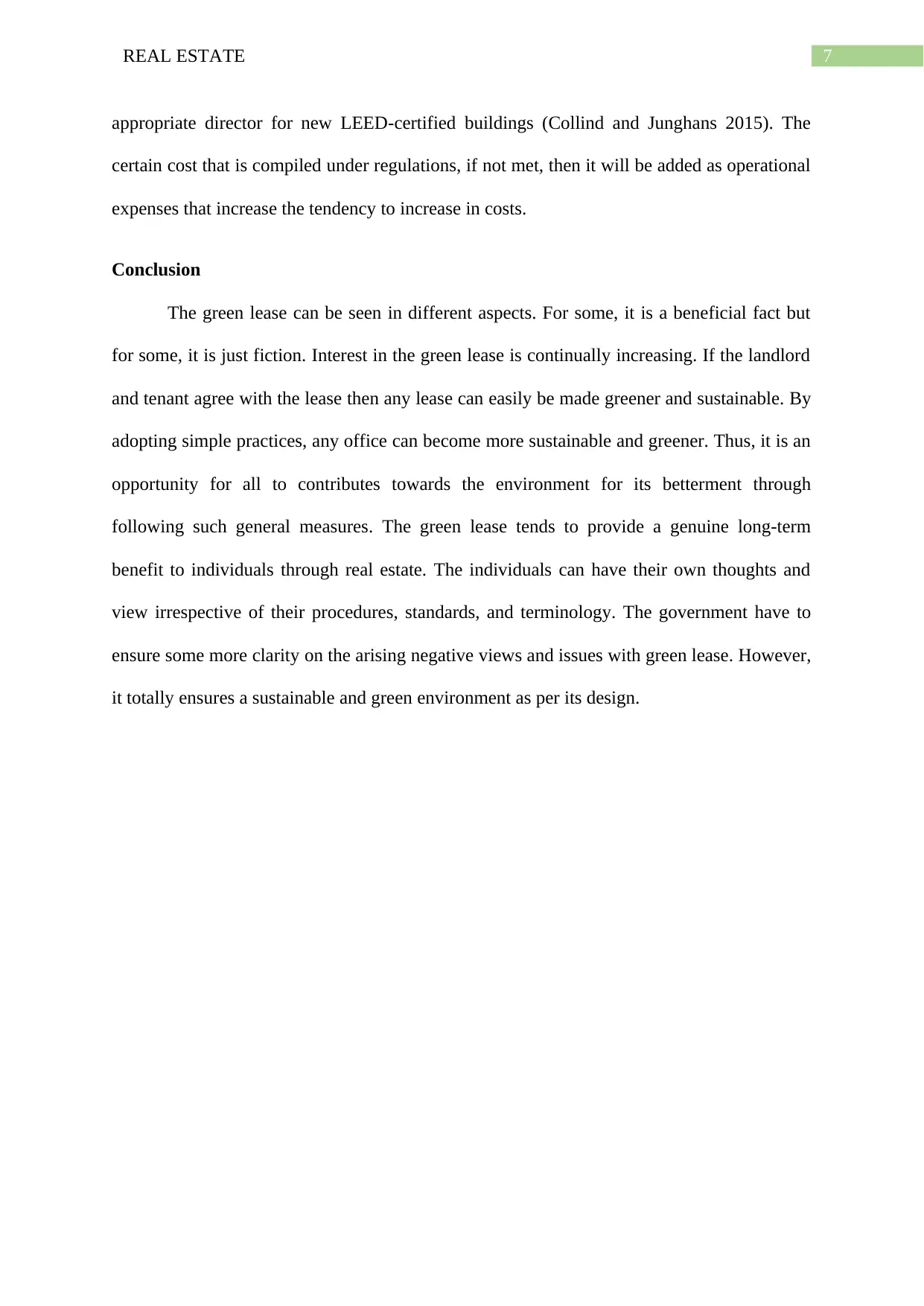
7REAL ESTATE
appropriate director for new LEED-certified buildings (Collind and Junghans 2015). The
certain cost that is compiled under regulations, if not met, then it will be added as operational
expenses that increase the tendency to increase in costs.
Conclusion
The green lease can be seen in different aspects. For some, it is a beneficial fact but
for some, it is just fiction. Interest in the green lease is continually increasing. If the landlord
and tenant agree with the lease then any lease can easily be made greener and sustainable. By
adopting simple practices, any office can become more sustainable and greener. Thus, it is an
opportunity for all to contributes towards the environment for its betterment through
following such general measures. The green lease tends to provide a genuine long-term
benefit to individuals through real estate. The individuals can have their own thoughts and
view irrespective of their procedures, standards, and terminology. The government have to
ensure some more clarity on the arising negative views and issues with green lease. However,
it totally ensures a sustainable and green environment as per its design.
appropriate director for new LEED-certified buildings (Collind and Junghans 2015). The
certain cost that is compiled under regulations, if not met, then it will be added as operational
expenses that increase the tendency to increase in costs.
Conclusion
The green lease can be seen in different aspects. For some, it is a beneficial fact but
for some, it is just fiction. Interest in the green lease is continually increasing. If the landlord
and tenant agree with the lease then any lease can easily be made greener and sustainable. By
adopting simple practices, any office can become more sustainable and greener. Thus, it is an
opportunity for all to contributes towards the environment for its betterment through
following such general measures. The green lease tends to provide a genuine long-term
benefit to individuals through real estate. The individuals can have their own thoughts and
view irrespective of their procedures, standards, and terminology. The government have to
ensure some more clarity on the arising negative views and issues with green lease. However,
it totally ensures a sustainable and green environment as per its design.
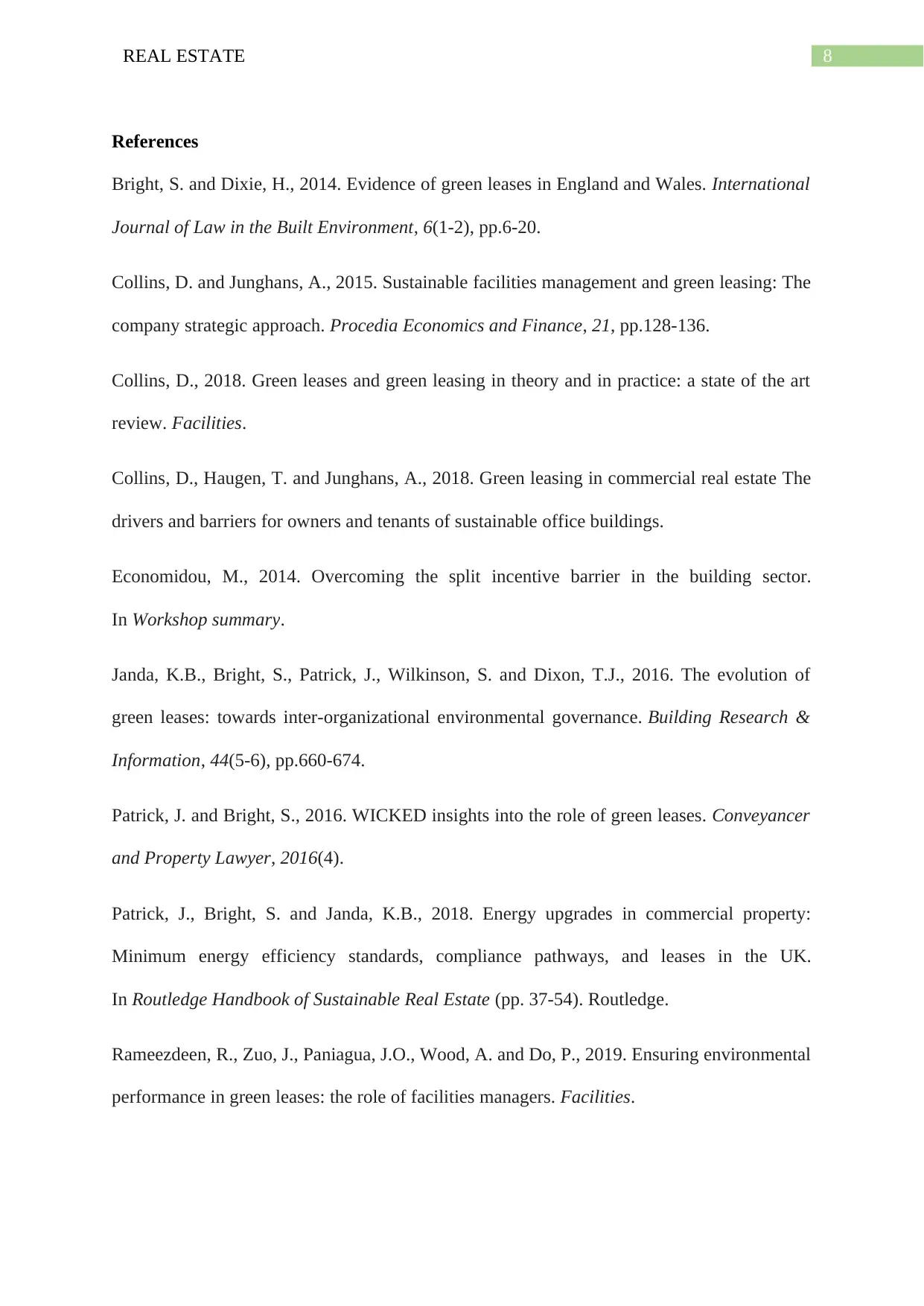
8REAL ESTATE
References
Bright, S. and Dixie, H., 2014. Evidence of green leases in England and Wales. International
Journal of Law in the Built Environment, 6(1-2), pp.6-20.
Collins, D. and Junghans, A., 2015. Sustainable facilities management and green leasing: The
company strategic approach. Procedia Economics and Finance, 21, pp.128-136.
Collins, D., 2018. Green leases and green leasing in theory and in practice: a state of the art
review. Facilities.
Collins, D., Haugen, T. and Junghans, A., 2018. Green leasing in commercial real estate The
drivers and barriers for owners and tenants of sustainable office buildings.
Economidou, M., 2014. Overcoming the split incentive barrier in the building sector.
In Workshop summary.
Janda, K.B., Bright, S., Patrick, J., Wilkinson, S. and Dixon, T.J., 2016. The evolution of
green leases: towards inter-organizational environmental governance. Building Research &
Information, 44(5-6), pp.660-674.
Patrick, J. and Bright, S., 2016. WICKED insights into the role of green leases. Conveyancer
and Property Lawyer, 2016(4).
Patrick, J., Bright, S. and Janda, K.B., 2018. Energy upgrades in commercial property:
Minimum energy efficiency standards, compliance pathways, and leases in the UK.
In Routledge Handbook of Sustainable Real Estate (pp. 37-54). Routledge.
Rameezdeen, R., Zuo, J., Paniagua, J.O., Wood, A. and Do, P., 2019. Ensuring environmental
performance in green leases: the role of facilities managers. Facilities.
References
Bright, S. and Dixie, H., 2014. Evidence of green leases in England and Wales. International
Journal of Law in the Built Environment, 6(1-2), pp.6-20.
Collins, D. and Junghans, A., 2015. Sustainable facilities management and green leasing: The
company strategic approach. Procedia Economics and Finance, 21, pp.128-136.
Collins, D., 2018. Green leases and green leasing in theory and in practice: a state of the art
review. Facilities.
Collins, D., Haugen, T. and Junghans, A., 2018. Green leasing in commercial real estate The
drivers and barriers for owners and tenants of sustainable office buildings.
Economidou, M., 2014. Overcoming the split incentive barrier in the building sector.
In Workshop summary.
Janda, K.B., Bright, S., Patrick, J., Wilkinson, S. and Dixon, T.J., 2016. The evolution of
green leases: towards inter-organizational environmental governance. Building Research &
Information, 44(5-6), pp.660-674.
Patrick, J. and Bright, S., 2016. WICKED insights into the role of green leases. Conveyancer
and Property Lawyer, 2016(4).
Patrick, J., Bright, S. and Janda, K.B., 2018. Energy upgrades in commercial property:
Minimum energy efficiency standards, compliance pathways, and leases in the UK.
In Routledge Handbook of Sustainable Real Estate (pp. 37-54). Routledge.
Rameezdeen, R., Zuo, J., Paniagua, J.O., Wood, A. and Do, P., 2019. Ensuring environmental
performance in green leases: the role of facilities managers. Facilities.
⊘ This is a preview!⊘
Do you want full access?
Subscribe today to unlock all pages.

Trusted by 1+ million students worldwide
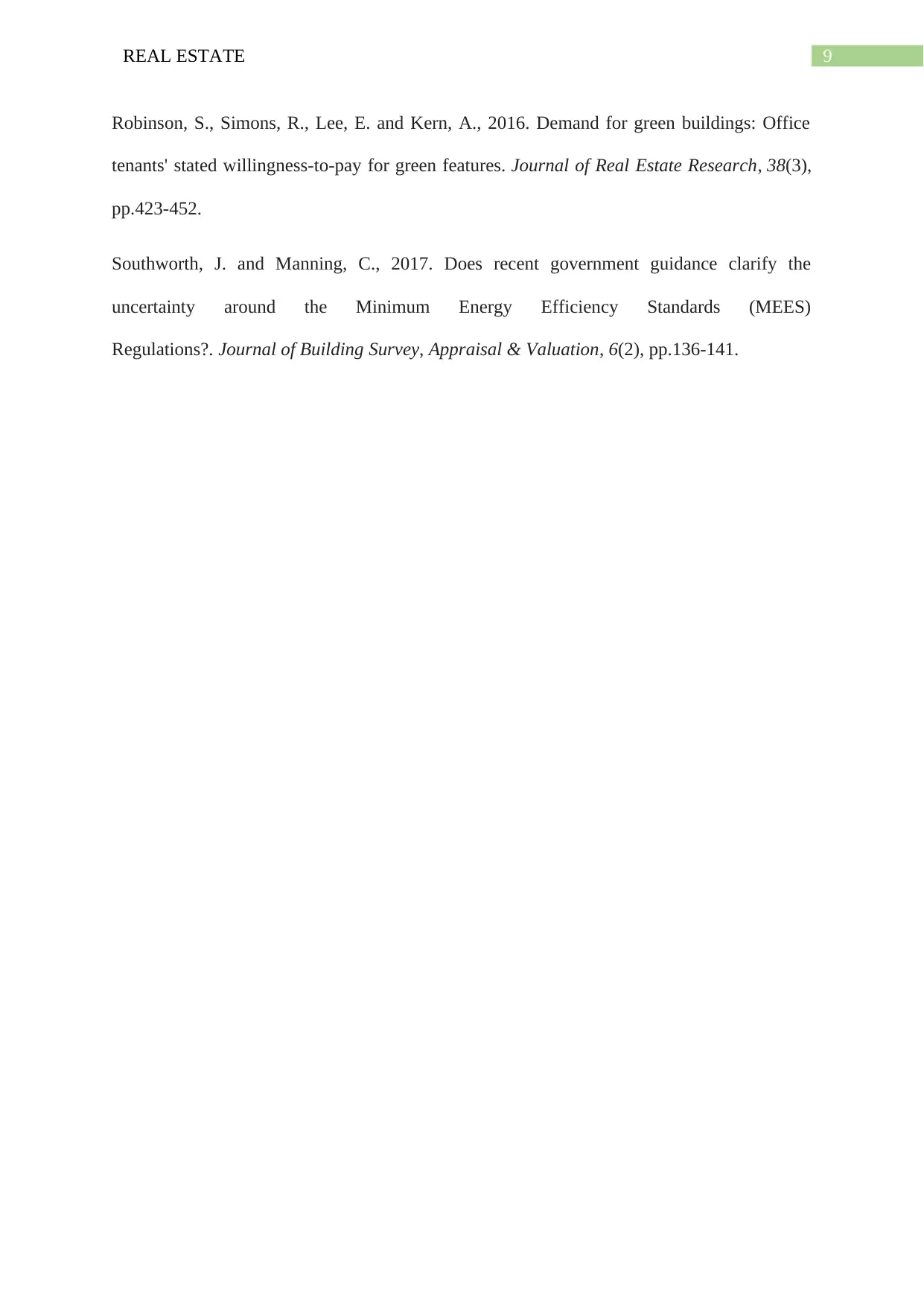
9REAL ESTATE
Robinson, S., Simons, R., Lee, E. and Kern, A., 2016. Demand for green buildings: Office
tenants' stated willingness-to-pay for green features. Journal of Real Estate Research, 38(3),
pp.423-452.
Southworth, J. and Manning, C., 2017. Does recent government guidance clarify the
uncertainty around the Minimum Energy Efficiency Standards (MEES)
Regulations?. Journal of Building Survey, Appraisal & Valuation, 6(2), pp.136-141.
Robinson, S., Simons, R., Lee, E. and Kern, A., 2016. Demand for green buildings: Office
tenants' stated willingness-to-pay for green features. Journal of Real Estate Research, 38(3),
pp.423-452.
Southworth, J. and Manning, C., 2017. Does recent government guidance clarify the
uncertainty around the Minimum Energy Efficiency Standards (MEES)
Regulations?. Journal of Building Survey, Appraisal & Valuation, 6(2), pp.136-141.
1 out of 10
Related Documents
Your All-in-One AI-Powered Toolkit for Academic Success.
+13062052269
info@desklib.com
Available 24*7 on WhatsApp / Email
![[object Object]](/_next/static/media/star-bottom.7253800d.svg)
Unlock your academic potential
Copyright © 2020–2025 A2Z Services. All Rights Reserved. Developed and managed by ZUCOL.





